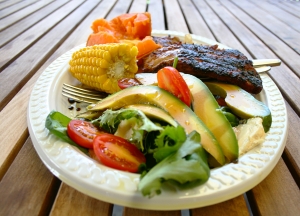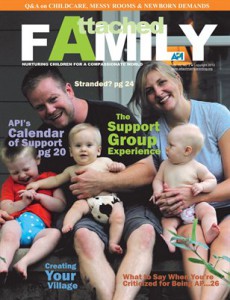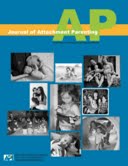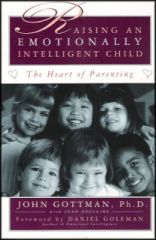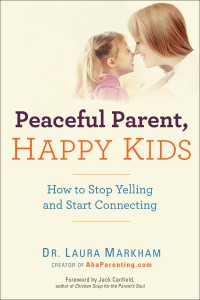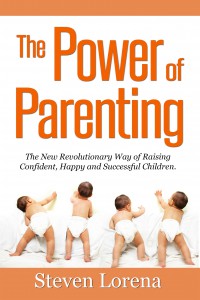By Brooke Campbell, MA, Licensed Creative Arts Therapist, Registered Drama Therapist and Board Certified Trainer, founder and director of Creative Kinections LLC, www.creativekinections.com. Originally published on www.relationshipadvicecafe.com, reprinted with permission.
 This article was challenging to put into words because parenting is not easily definable. Once we accept that there are no “perfect parents” and we all are in a process of learning and discovery, we will grow alongside our children’s development.
This article was challenging to put into words because parenting is not easily definable. Once we accept that there are no “perfect parents” and we all are in a process of learning and discovery, we will grow alongside our children’s development.
1. Be present with your presence. Parenting is messy and involves a continual process of being present. Parenthood is an act of doing and a state of being. Being present requires us to feel our own presence. This takes courage as we navigate through the inner landscape of our strengths and shortcomings. Those challenging parts of ourselves that are difficult to accept need our full attention like a crying infant or tantrumming toddler. When we neglect or avoid doing the hard “internal” work on ourselves, areas in our home and family life suffer. If we avoid the chaos within ourselves, how can we tolerate our own child’s chaos, struggles and problems?
Our children are astute creatures and experts at reading our non-verbal cues. When we are suffering, our children empathically know and sense it. If we are not able to role model our own set of ways to peacefully problem solve and use emotional intelligence, how will they feel safe enough to show us their pain? When we are not present within our daily lives, it delivers the message to our children that we are not capable of being able to handle their struggles.
State your feelings to your child and the reasons behind the emotion in an age-appropriate way. Empathy is learned. This doesn’t mean you can emotionally burden your child or use your feelings to manipulate or victimize. Your ability to name and express feelings safely is a powerful teaching lesson for your child.
2. Do your internal homework. Children are conditioned to complete and hand in their homework for a teacher to grade. As parents, we must initiate completing our own internal homework, including asking ourselves questions like:
-
Would I want to be parented the way I parent my own child?
-
What messages (spoken or unspoken) were sent to me during childhood from my family of origin? For example, some adults I work with share that they felt neglected, not good enough, ignored, misunderstood, silenced, abused, controlled, manipulated and isolated as children.
-
How are the messages I learned from childhood shaping my role as a parent?
-
Am I parenting my child the way I was parented? If so, was this a conscious or unconscious choice?
Your responses will serve as a guide on your parenting journey.
3. Envision yourself as your child. Parenting can be frustrating. Here is one activity to use for grounding your stress. One powerful and effective drama therapy intervention I use involves “role-reversal.” When we put our agendas aside and shift our perspective by thinking and feeling as our children, we gain a powerful amount of empathy and insight. Imagining yourself as your child can provide you with specific answers about his or her worries, concerns, struggles, frustrations, needs and wants. It is then your job to tune into what makes your child tick to inform your decision-making as parents. Instead of being influenced by outside forces, such as your own parents, in-laws, neighbors, friends and parenting books, when you imagine yourself as your child you will gain confidence in knowing what is needed to shape your child’s development.
4. Practice mirroring in movement and sound to create attunement. No matter what our child’s age or stage of development, he or she will alter negative behaviors, moods and attitudes when we reflect his or her body language and speech. Consider times when we become highly in tune during conversations with people we value. We begin to model their body language, repeat similar themes and words, and we may laugh at the same time. When our gestures, thoughts and feelings are mirrored back to us, we feel validated. Our children have a deep need to be validated and witnessed by us. It’s our responsibility to do so.
5. Develop a practice of action. Our children are always in action, even when they’re still. When we develop a practice of action, we allow moments to occur which bring our focus onto something outside of our child’s behavior and ourselves. Pass a ball, break out into song, get on the floor and play, turn the radio up, dance at home, read the book your teen is reading, play cards or your favorite board game. Even if your child’s action is slight, such as tapping a fork on the table or looking outside, take their cues so you can follow through with a seamless response.
You can also name what your child is doing and serve as a “double” for him or her. Doubling is a term that is used in the action-oriented form of psychotherapy called psychodrama, in which an individual communicates on a deeper level what the protagonist is experiencing, thus voicing the protagonist’s unspoken words. In this case, the protagonist is your child. Validate your child’s actions by naming them and the motivation behind them. Then follow up your validation by responding to the action in an intuitive way. Responding to your child’s actions could include mirroring, singing a song about the action, doing a dance inspired by the action or creating a character who would engage in your child’s same action. Be creative by taking your child’s cue to enter his or her world in order to develop a deeper sense of attunement. This shows your child you are listening, you understand him or her and you care.
6. Bring creativity and imagination to your parenting practice. Children, no matter the age or stage of development, are wired to think and behave outside of the box because of such intense levels of imagination and ability to express themselves. But they may experience periods of feeling helpless and powerless. They can’t make all decisions on their own or be fully independent. Experiences of powerlessness and helplessness have a vital need to be expressed. The expression needs a safe place to land. This may mean blowing bubbles in your house, ripping paper up to get frustrations out, or you enacting your child’s feelings in an emotionally intelligent way, such as, “I’m so mad my toy broke! Now I can’t play with it.” To foster your child’s ability to express, try enrolling yourself as a clown or a child, or gather leaves to create art. Your children will thank you because you gave them the gift of expression.
7. Break out of your patterns. Children do thrive on routine, but they also need us to break out of ours in order to witness their needs and challenges. In my ten years as a drama therapist, I have encountered parents who kept forcing their children to fit into squares when the children were clearly circles. This analogy is used to inform us that we need to break out of our patterns and ways of operating, behaving and thinking to be attuned to our children. Parenting is not about convenience. It’s about commitment to positively shaping their development. If our pattern also matches our child’s pattern of operating, then what we’re doing is working. If we are imposing our control on our child to meet our needs at the expense of our child, then we need to make some important changes and make them immediately.
8. Imagine fast-forwarding your life: Picture your children as adults. Children grow before our eyes, and I know how challenging it is to accept our child’s fast-paced development. If, for a moment, you imagine your children as adults, what kind of life do you envision them living? Do not imagine how you want them to live. Base your child’s imagined future on his or her strengths, skill set, personality and temperament. How do you picture them as adults? Do they feel competent? Are they independent? Are they happy? The information you have now about your child will guide your ability to envision your child’s potential future as an adult. If you have a strained relationship with your child now, how will that affect his or her future as an adult? You are laying the foundation for the house of your child’s life. Is your child’s foundation built on quicksand or steady ground?
9. Imagine your daughter/son wrote you a letter. If your child were to write you a letter about how he or she experiences you as a parent, what would it say? The thing is, you know the areas in the way you parent that need work–the parts that you may be ashamed of or feel out of control about. If your child wrote about your need for control, your shame, your fear, your anxiety and your rage, how would it feel to have someone know your truth? What changes would you make as a parent now to work through your parenting challenges?
10. Imagine your child becoming a parent. When your child becomes an adult, segueing into parenthood, what kind of parent will he or she become? Our children most likely will take on qualities of how we parented them, since our treatment toward our children is a learned behavior. Yes, we as humans are imperfect beings. Where can we make positive shifts in our own parenting choices to implement a strong framework for our children for when they have a family of their own?
11. Develop adaptability and accept change. One tip for parenting and for coping through life’s struggles is developing an open approach to adapting and accepting change. Parenting, like childhood, is about fluidity, flexibility and change, which also mirrors the ebb and flow of tidal waves.
Practically speaking, this means that we may need to alter our behavior, approach, communication style, actions and life choices. When children enter our lives, they metaphorically hold a mirror up to us and encourage us to change, just like they transform as they grow.
12. Take your child’s lead. Children are born innocent, curious and creative. When you accept that children have equal rights as adults, you will notice positive shifts in your parenting approach. Be curious about life, people, experiences, textures, colors, problems, seasons, etc. Activate your sense of touch, sound, sight, taste, and smell. When we jump into our child’s world of imagination and curiosity, we heal our wounded child within, and we strengthen our relationship with our child. The message here is take your child’s lead. Usually when we take our child’s lead, moments transform and negative behavior and moods shift.
